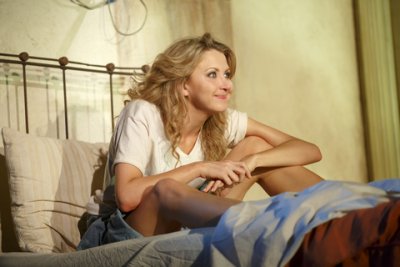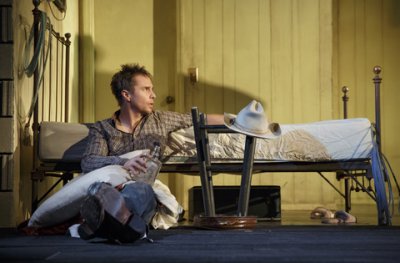Fool for Love
A frenetic but lackluster revival of Sam Shepard’s modern classic chiefly due to the capable but less than riveting performances of its two stars.
[avatar user=”Darryl Reilly” size=”96″ align=”left” ] Darryl Reilly, Critic[/avatar] You can’t keep messing me around like this. It’s been going on too long. I can’t take it anymore. I get sick every time you come around. Then I get sick when you leave. You’re like a disease to me.
Nina Arianda and Sam Rockwell have each demonstrated during their careers that they are fine actors but in this weak revival of Sam Shepard’s autobiographical romantic modern classic Fool for Love they both lack the innate charisma to fully succeed at their roles as larger than life tempestuous lovers.
They employ Western twangs and drink tequila. He wears jeans and a cowboy hat, is laconic, and twirls a lasso terrifically. She is often scantily dressed and is earthy. They clash verbally and physically with studied effects that come across as dutiful acting rather then raw intensity. Their performances are capable but are ultimately superficial in relation to the demands of this work. “The play is to be performed relentlessly without a break” is the first and most crucial of Shepard’s stage directions. Due to this casting that’s not really achieved and so the 75 minutes are often sluggish.
The play takes place in “The present” at “ A motel room on the edge of the Mojave Desert.” There we meet Eddie and May a volatile couple who have had a fiery on and off relationship for 15 years since they met in high school. He is there to reconcile with her but is interrupted by her current romantic companion, the good-natured Martin. Also around and sitting in a chair but not part of the action as he exists in the minds of some of the characters is The Old Man. He is a cryptic figure who spouts reminiscences and observations including his obsession with country singer Barbara Mandrell. In the course of the events, his exact identity is revealed. The dialogue ranges from terse to colorful and contains a number of emotionally expressive monologues.
Shepard directed the original production that opened in February 1983 at The Magic Theatre in San Francisco. It then went to New York City’s Off-Broadway Circle Rep in May of that year and soon after transferred to the Douglas Fairbanks Theatre on West 42nd Street where it ran for 1000 performances until September 1985.
The emerging but relatively unknown Ed Harris and Kathy Baker were the original Eddie and May and both won Obie Awards for their performances as did Shepard for his direction as well as for Best New American Play. Fool for Love was also a finalist for The Pulitzer Prize for Drama in 1984. Bruce Willis was Ed Harris’ understudy and was a replacement as was Aiden Quinn and Will Patton. Frances Fisher and Ellen Barkin were replacements for Kathy Baker.
The 1984 London production starred Julie Walters and Ian Charleson in acclaimed performances. Robert Altman directed a 1985 film adaptation that starred Shepard as Eddie, Kim Bassinger as May, Harry Dean Stanton as The Old Man, and Randy Quaid as Martin. These historical facts are a testament to the play’s popularity and cultural significance at that time.
This production began in July of 2014 at The Williamstown Theater Festival where it was critically hailed and is now being presented on Broadway by Manhattan Theatre Club and is the play’s Broadway premiere with much of that original cast.
A notable effect is the sound of slamming doors in the motel room that is specified by Shepard: “The door is amplified with microphones and a resonator hidden in the frame so that time an actor slams it the door booms loud and long.” Sound designer Ryan Rumery expertly achieves this.
Dane Laffrey’s scenic design of the motel room is detailed and suitably atmospheric. Lighting designer Justin Townsend’s work captures the mystery and moods of the play. Anita Yavich’s costumes are appropriately Western. David S. Leong’s choreography of the movements and fights is impressive. Though this design team is highly proficient the overall effect of their efforts is overblown and threatens to overwhelm the power of the play.
This is the fault of director Daniel Aukin who also staged it at The Williamstown Theatre Festival. Besides obtaining just competent performances from his cast, he has chosen a shallow high-tech approach in staging this small-scale but profound masterpiece by a writer at the peak of his powers in a Broadway theater rather then creatively reimagining it with meaningful aesthetic simplicity.
Gordon Joseph Weiss is affable as The Old Man but doesn’t convey much depth. As Martin, Tom Pelphrey creates a charming and engaging characterization of a well-meaning suitor.
Photographer Alfred Wertheimer’s iconic 1956 black and white photograph “The Kiss” of 21 year-old Elvis Presley tongue-locked with a young blonde woman backstage after a concert in a stairwell was used for the poster and program for the original New York and London productions and on the cover of the published edition of the play. Fool for Love’s tantalizing passion is captured in this alluring image and that quality is woefully absent in this adequate and lackluster revival.
Fool for Love (extended through December 13. 2015)
Manhattan Theatre Club at the Samuel J. Friedman Theatre
261 West 47th Street, in Manhattan
For tickets, call 800-447-7400 or visit http://www.manhattantheatreclub.com
Running time: 80 minutes with no intermission









Leave a comment